How to Grow and Care for Lady Slipper Orchids (Cypripedium)
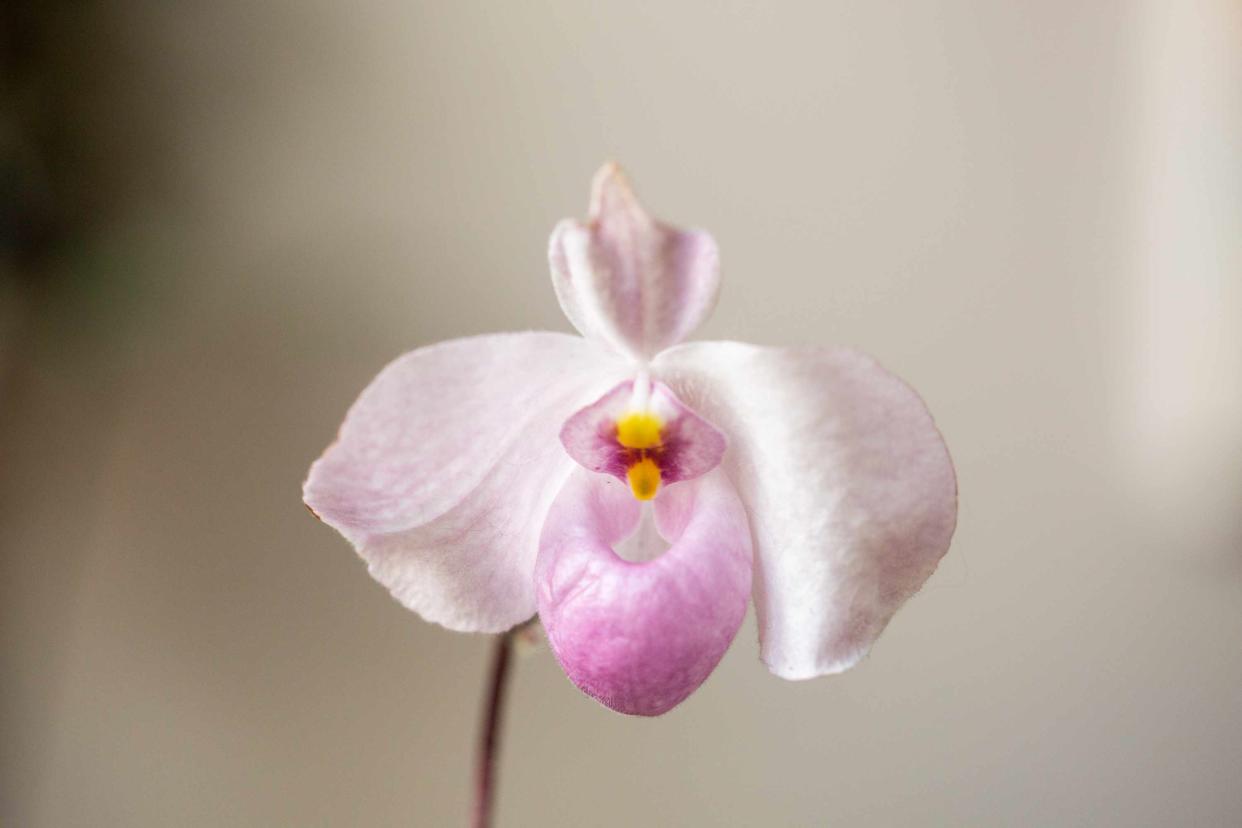
The Spruce / Phoebe Cheong
Reviewed by Julie Thompson-Adolf
Lady Slipper orchids come in unusual shapes and color patterns, and some are rare, at risk or endangered. Belonging to the orchid genus Cypripedium, lady slipper orchids are the most primitive type found today. Most are terrestrial, growing in the ground in temperate zones around the globe.
The genus includes lady slipper orchids and moccasin flowers native to the northern hemisphere, characterized by a pouched lip that resembles the toe of a shoe or slipper.
Certain states in the U.S. identify several species as endangered or at risk. This is due largely to over harvesting and habitat destruction. These rare orchids require very specific growing conditions and are slow to germinate and colonize.
Common Name | Lady slipper orchid |
Botanical Name | Cypripedium |
Family | Orchidaceae |
Plant Type | Perennial monocot |
Mature Size | 6-15 in., flower spikes to 40 in. |
Sun Exposure | Low, indirect |
Soil Type | Loose, well-draining, bark, moss |
Soil pH | Neutral 6.0 to 7.0 |
Bloom Time | Mid-winter and mid-summer |
Flower Color | Mixed and varied combinations |
Hardiness Zones | 2-9 (USDA) |
Native Area | Europe, Asia, North America |
Lady Slipper Orchid Care
Lady slipper orchids are sympodial, which means they have multiple growing points along a horizontal stem. This orchid genus does not often produce tall plants, although there are exceptions. In native areas, most reach only about 6 to 8 inches high with flower spikes around 15 inches. Different species identify as either warm or cool growing, so care differs slightly depending on your particular orchid. Ask your grower about its native origins, particularly the elevation, of your plant.
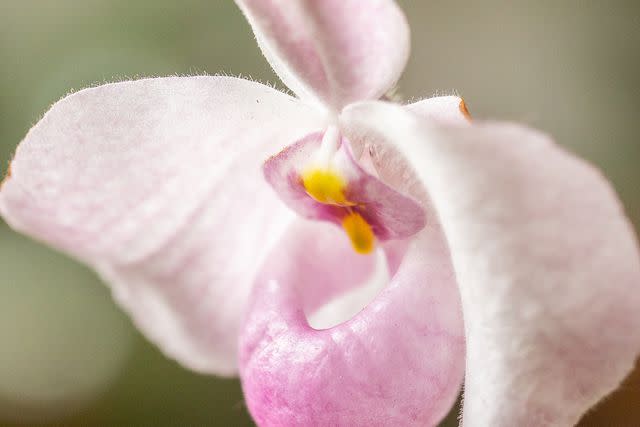
The Spruce / Phoebe Cheong
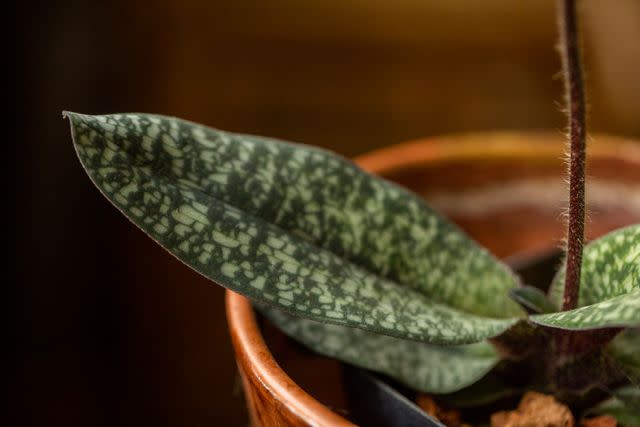
The Spruce / Phoebe Cheong
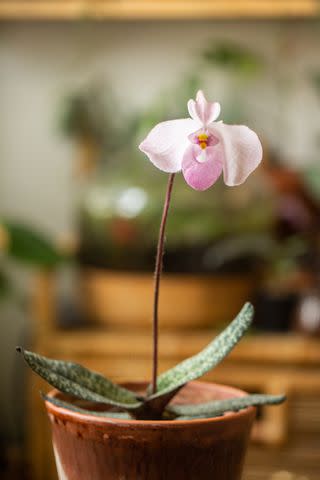
The Spruce / Phoebe Cheong
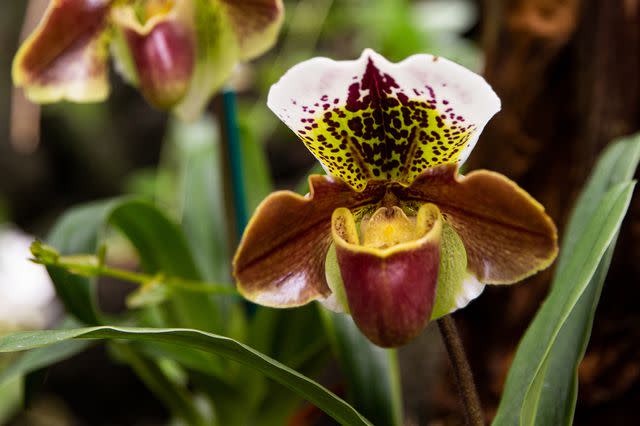
The Spruce / Phoebe Cheong
Light
This is a low-light orchid that requires shade. Place it in an east-facing or a shaded south-facing window. Fluorescent lighting also works well. Suspend lights 6 to 12 inches above the foliage. Grown outdoors, some varieties of these terrestrial orchids prefer full sun in the morning with afternoon shade. Other varieties prefer only dappled sun throughout the day.
Text Link:The 10 Best Grow Lights of 2023, Tested and Reviewed
Soil
Most are terrestrial orchids that grow in very specific types of soil. Good choices for potting material include shredded osmunda bark, medium grade fir bark and crushed dried oak leaves. Avoid packing the mix too tightly.
Water
Like other sympodial orchids, lady slipper orchid stems have pseudobulbs for storing water and nutrients, so they can go a while between waterings without suffering. Depending on the growing environment, your orchid may need water twice a week.
Avoid chemically treated water or allow it to sit out for several days before using. Potting medium should stay moist but never soggy, though some varieties that grow in boggy conditions may prefer a wetter medium.
Others can grow indoors but need very specific temperatures, with a 10-15 degree temp drop at night.
Temperature
Mottled leaf types thrive in daytime temperatures between 75 and 85 degrees F. and nighttime temperatures from 60 to 65 degrees F. Keep green leaf types between 75 and 80 degrees F. during the day and 50 to 60 degrees F. at night. These are recommended temperatures, but many growers are successful growing both types in the same temperature range.
Moderate humidity of 40 to 50 percent is adequate and can be maintained by setting the orchid pot on a tray of gravel partially filled with water. Water should not touch the bottom of the pot. If humidity is low avoid letting moisture sit on the leaves or crown of the plant. When humidity is high, air movement is essential which might require a fan or dehumidifier.
For the varieties that prefer boggy conditions, humidity levels may need be higher. Those varieties will also require a temperature drop of 10 to 15 degrees overnight.
Fertilizer
Lady slipper orchids are sensitive to fertilizer; they have fleshy, hairy roots that are easily burned if too much fertilizer is applied. How often and what strength to add depends partly on the growing medium. Osmunda bark contains nutrients, so it requires less frequent and potent fertilizer solutions. If your orchid is potted in fir bark, use a high-nitrogen fertilizer such as 30-10-10. Suggestions include 1/4 to 1/2 strength applied once every two weeks.
The orchid should be flushed with clear water once monthly to a remove harmful salts.
Types of Lady Slipper Orchids
Cypripedium acaule (pink lady slipper) produces deep pink flowers 3 inches long from late June into July. This is a fragrant type with a sweet floral scent.
Cypripedium calceolus (yellow lady slipper) sends up a buttery yellow flower in early spring and is found mostly in rich woodlands or along bog edges.
Cypripedium parviflorum pubescens (greater yellow lady slipper) can grow up to 2 feet tall, with flower petals up to 6 inches across.
Cypripedium reginae (showy lady’s slipper) is another large species, 1 to 2 feet tall with pink-streaked, white flowers appearing in late spring/early summer. It grows naturally in wetlands and damp meadows.
Cypripedium candidum (white lady’s slipper) is a small type from 6 to 12 inches tall. Considered endangered it may be available from reputable nurseries.
Pruning
Pruning lady slipper orchids is seldom needed. It is a good idea, though, to examine the plant annually after blooming and add fresh potting materials. Remove any diseased leaves or brown roots to avoid root rot spreading.
Propagating Lady Slipper Orchids
Lady slipper orchids reproduce in three ways. Thousands of tiny seeds are dispersed by wind but only germinate in specific types of fungi. They also reproduce and colonize through spread of the rhizome. Germination can take several years, and even division seldom produces a plant mature enough to bloom in the first five years. These are complex methods requiring a greenhouse growing environment best left to orchid specialists.
Some varieties form keikis which is the easiest method to propagate your plant. It's a little more involved them removing a keiki from some other types of orchids, but it can be accomplished with the right patience and care. Gather together a small pot, planting medium, fungicide and a sharp sterile cutting tool, then follow these steps.
When you see the keiki begin to form, mound up potting medium around the baby stem, as if to create a pot within the original orchid pot.
Keep an eye out for the keiki to begin to develop roots.
Once several viable roots are present, use the blade to remove the baby orchid from the mother plant, making sure to include the roots.
Treat the cut end of the stem with fungicide. Do not apply fungicide to the roots.
Place the baby orchid in its own small 2 to 4 inch pot filled with osmunda and/or fir bark and dry shredded leaves.
Gently but thoroughly water letting all excess drain away. Then place the orchid in shade or in a location that receives very little indirect light.
Once you see new growth, move the orchid to a more permanent spot, keeping in mind this plant prefers shade and low, dappled light.
Potting and Repotting Lady Slipper Orchids
Lady slipper orchids fare best when not too pot bound, however they do not need large pots. If you do have a lady slipper orchid that has matured to reproduce new stems, it's recommended to keep no more than three stems in one pot. Six-inch pots with good drainage holes are sufficient.
The orchid can be repotted every year or two, either in the same pot or a new one. Repotting is done mainly to replace spent material and should take place once the bloom period is complete. This is the best time to examine the orchid and take care of any pruning. Here's what to do.
Grasp the main stem and turn the pot upside down. The orchid should slide out easily along with loose medium.
Inspect the leaves, roots, and any flower spikes still attached.
Proceed with necessary pruning. Cut back flower spikes, dried or damaged leaves and spent roots.
If using the original pot, inspect it for evidence of salt buildup (white chalky areas) or other fungus. Clean and sterilize the pot if necessary or choose a new pot.
Place the orchid in the pot adding planting medium in and around the roots. Be sure to cover the rhizome. If aerial roots are present, allow them to grow in their natural direction and avoid trying to force them into the pot.
Water gently but thoroughly and give the orchid several days to a week to recover before continuing regular fertilization.
Common Pests & Plant Diseases
Mealybugs are the most common pest of lady slipper orchids, identified by small, white, cottony webs on the undersides of leaves. Gently swab affected areas with a q-tip dipped in isopropyl alcohol.
Small dark spots or patches that develop on flowers indicate botrytis petal blight. This is usually the result of too much humidity or poor air circulation. Remove affected parts and try installing a fan or relocate the orchid to a brighter location. Make sure, though, the plant receives only dappled indirect light.
How to Get Lady Slipper Orchids to Bloom
Lady slipper orchid blooms can last as long as three months and produce flowers at least once annually. Most produce just one or two flowers but some newer hybrids produce many. After flowering in early summer, lady slipper orchids will die back until the following spring when it begins to grow again.
Support flowering by using a fertilizer slightly higher in phosphorous as the bloom period approaches. Keep the orchid in total darkness at night.
As with all orchids, the best way to insure flowering is to develop a specific, consistent care routine.
Common Problems With Lady Slipper Orchids
Most issues arise from improper maintenance involving incorrect light exposure, temperature fluctuations, or watering.
Yellowing Leaves With Black Spots
This problem can crop up when the orchid is exposed to cold or wide temperature fluctuations.
Dry or Dark Leaf Tips or Edges
The orchid may be sunburned. Be sure to place it where it receives only dappled, indirect light.
Stunted Growth or Sudden Flower Loss
Always use lukewarm or room temperature water. Cold water can damage roots.
Frequently Asked Questions
Are lady slipper orchids difficult to grow?
Yes, lady slipper orchids are difficult to grow. Some hybrid species may be appropriate for beginners, but many require specialized environments like a greenhouse nursery for at least the first two years.
Can I dig up a lady slipper orchid growing on my property?
It is not illegal to wild harvest plants on your own property. It's a good idea, though, to check with your state's endangered plant list. Never wild harvest a single plant. Instead look for a colony and take only what you need.

